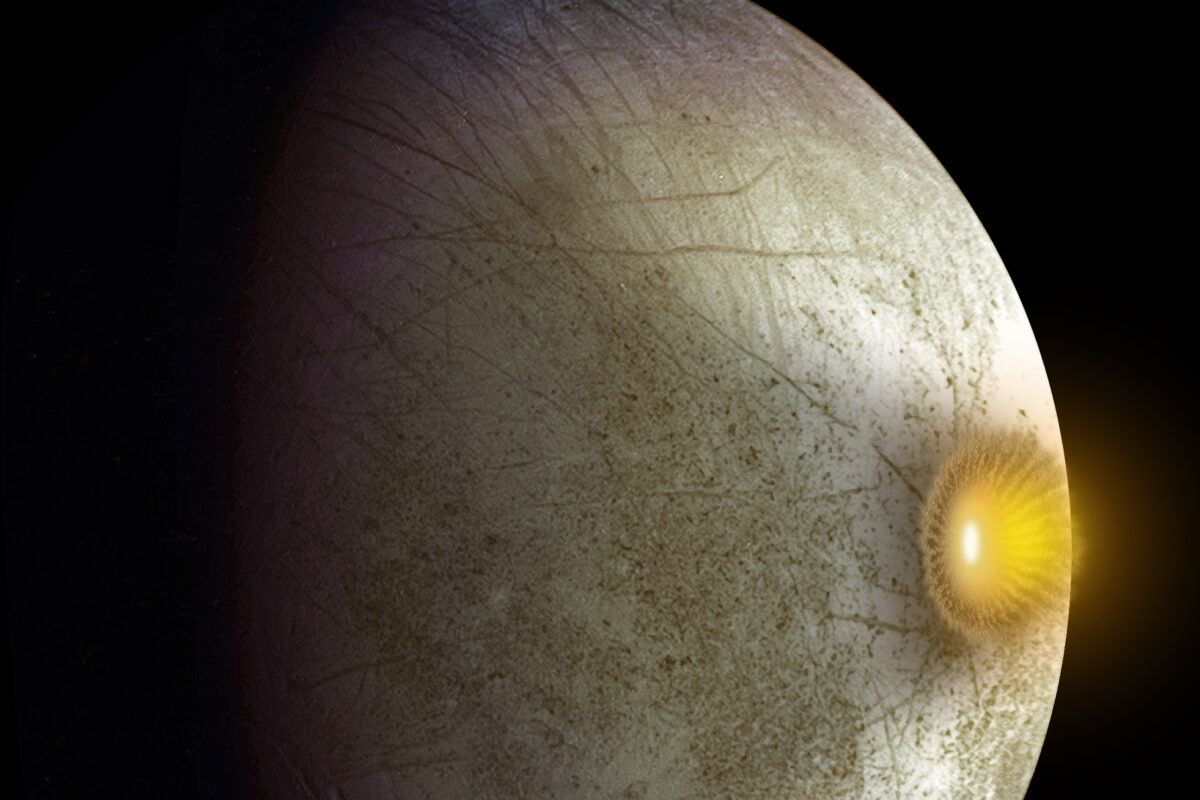Jupiter is the most-visited planet in the Solar System, thanks largely to NASA. It all started with Pioneer 10 and 11, followed by Voyager 1 and 2. Those were all flyby missions, and it wasn’t until 1996 that the Galileo spacecraft became the first to orbit the gas giant and even send a probe into its atmosphere. Then in 2016, the Juno spacecraft entered orbit around Jupiter and is still there today.
All of these missions were focused on Jupiter, but along the way, they gave us tantalizing hints of the icy moon Europa. The most impactful thing we’ve learned is that Europa, though frozen on the surface, holds an ocean under all that ice. And that warm, salty ocean might contain more water than all of Earth’s oceans combined.
Might it hold life?
A new research letter examines how comets could play a role in life on Europa. Its title is “Surface-To-Ocean Exchange by the Sinking of Impact-Generated Melt Chambers on Europa,” and it’s published in the AGU’s Geophysical Research Letters. The lead author is Evan Carnahan, a doctoral student at UT Austin.
The study examines comet impacts on Europa and how they could deliver important chemicals from the moon’s frigid surface to the warm, subsurface ocean. Europa’s ice shell is a barrier tens of kilometres thick, and it’s hard to envision a scenario where a comet could break through all that ice. But the authors say it might not have to. Instead, a comet might only need to make it halfway through all that ice, and natural conditions would do the rest.
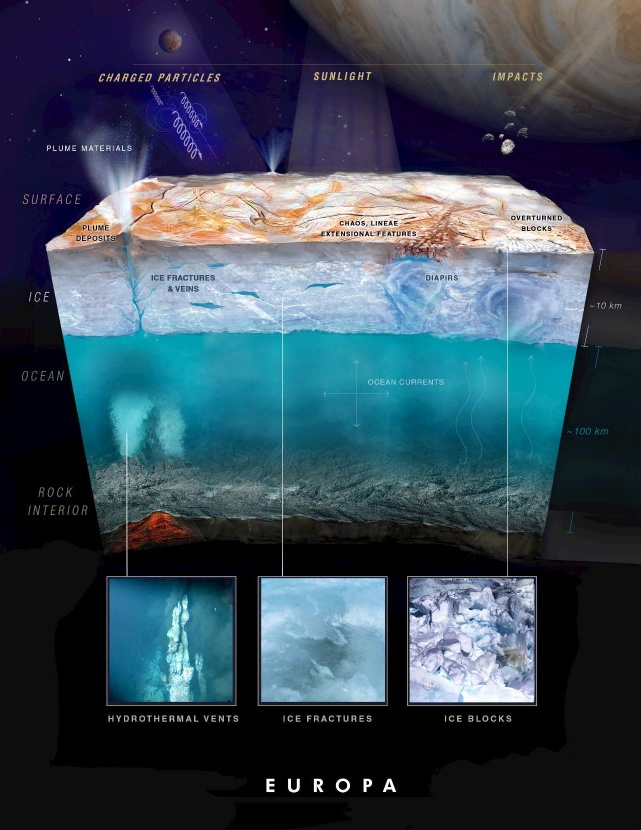
The study is based on a computer model of Europa and its complex, layered structure. The model showed that the heat from an impact would create a body of meltwater. The meltwater would founder and sink through the ice into the ocean in what the researchers call a viscous foundering mechanism. And it would carry oxidants— a class of chemicals that life needs—with it from the moon’s surface down into the warm ocean. Once there, they could help sustain any life that’s present.
“Once you get enough water, you’re just going to sink,” said lead author Carnahan. “It’s like the Titanic times 10.”
This isn’t the first attempt to understand how comets could transport life-related chemistry to Europa’s ocean. But much of that work showed that the comet would have to fully pierce the ice and reach the ocean to deliver surface chemicals. If this is true, then only the largest comets could do the job, severely restricting the chances of it ever happening.

This study suggests otherwise. By showing that a comet needn’t penetrate all the way to the ocean, it broadens the range of potential comets that could deliver chemicals.
“This increases the probability that you would have the necessary chemical ingredients for life,” said co-author Marc Hesse, who is a professor at the UT Jackson School of Geosciences Department of Geological Sciences.
Europa naturally produces oxidants on its surface via radiolysis and photolysis. Radiolysis is the dissociation of molecules by radiation, and it stems from Jupiter’s intense radiation and powerful magnetic fields. The gas giant’s rotating magnetosphere traps charged particles, and those particles overtake Europa as it orbits Jupiter. The moon’s tenuous atmosphere is no defence, and when these particles have high enough energy, they can bore right into the ice. There they produce oxidants necessary for life.
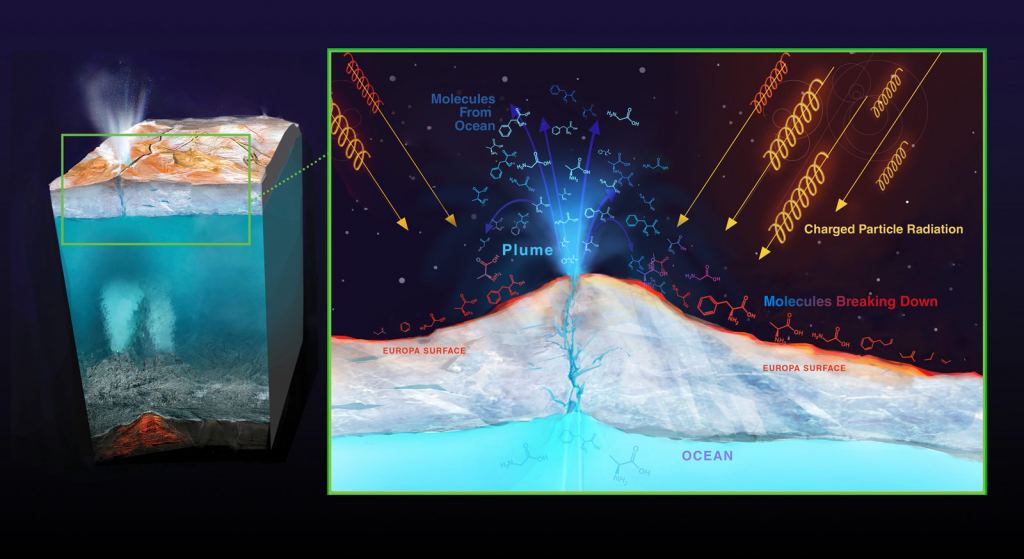
Photolysis is similar to radiolysis but is driven by light. When energy from the Sun strikes Europa’s water plumes, photolysis (also called photodissociation) breaks water molecules apart and produces oxygen. So due to both photolysis and radiolysis, Europa’s surface and immediate subsurface contain important chemicals for carbon-based life.

Scientists already know how these processes create chemicals on Europa’s surface. But the research team’s computer models of Europa and comet impacts take it all a step further.
Europa is the smoothest object in the Solar System. The moon’s surface is tectonically active, and all that activity erases impacts over time. But scientists have still spotted dozens of craters there. Some Europan craters have a distinctive appearance and look like concentric rings of ripples. That suggests “… frozen meltwater and post-impact motion beneath the crater,” according to a press release presenting the research.
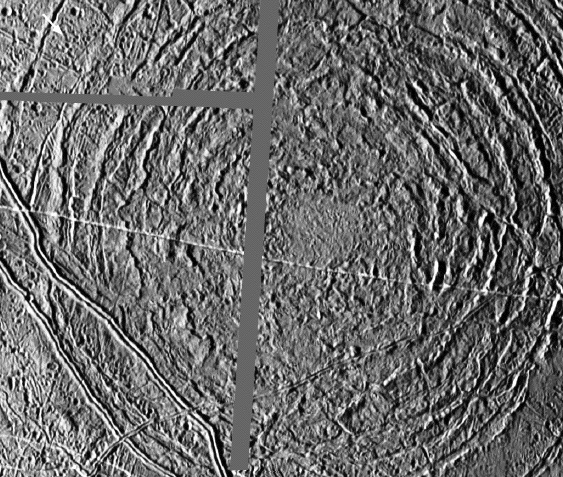
So there’s evidence of important chemicals on Europa’s surface, and there’s also evidence of impacts. The question the researchers wanted to explore is how the two could combine to deliver chemicals to the ocean.
They’re not the first ones to ask this question. A 2015 study showed that a 0.5 km diameter comet would penetrate 5 km of ice, and a 5 km diameter comet could breach 40 km of ice. We don’t know yet exactly how thick Europa’s ice is, but 40 km is the thickest estimation. The 2015 study showed that even if Europa’s ice were 40 km thick, a comet large enough to breach it would impact the moon every 250 million years. If the ice is less thick, between 8 to 13 km, then comets in the range of 0.7–1.5 km diameter would breach the ice every 3 to 7 million years.
Because Europa has such a thick, layered ice shell, craters created by comets or other impactors are transient. The surface evidence remains for millions of years, but the transient crater that penetrates the ice doesn’t last long. Europa’s ocean and ice are convective, and any crater that goes deep into the ice quickly fills in. The 2015 study showed the ratio between the depth and the diameter of these craters and how they correlate with different ice thicknesses. The results showed which sizes of existing surface craters likely produced a water column that reached from the surface to the ocean, potentially allowing surface chemicals into the ocean.
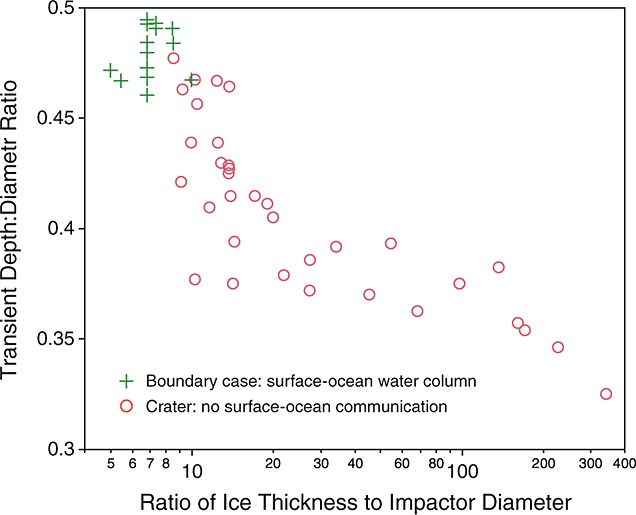
This new research models the impact environment after a comet strikes the surface to show how the impact might carry existing surface chemicals through the ice and into the ocean. It showed that breaching the ice shell’s midpoint is critical. If that happens, over 40% of the meltwater from the impact will reach the subsurface ocean.
That can be a lot of meltwater and can transport a lot of surface chemicals to the warm ocean. If a comet 800 meters (one half-mile) wide reached the mid-depth point of the ice, it would deliver enough water to fill Oregon’s crater lake. That’s 18.7 km3 or 4.49 cu mi of water. (One cubic mile is more than 1 trillion gallons/3.8 trillion litres.) That could happen every three million years if the 2015 study is correct.
Europa’s Manannan Crater is 30 km (18.6 miles) in diameter and is one of the moon’s largest craters. The crater is the subject of a lot of research due to its prominence in images and data from the Galileo mission. It has unusual “spider terrain” that might be a critical clue. It might be evidence that the impactor that created it caused a deep enough transient crater to transport surface chemicals to the ocean.
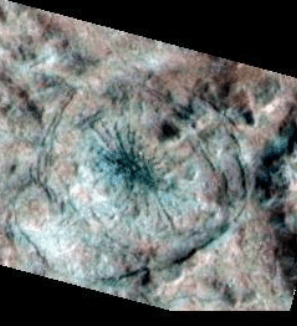
The team modelled the Manannan Crater and its post-impact melt chamber. The simulation shows the meltwater sinking into the ocean within several hundred years after impact. Their results also showed that the impact could create a channel from the ocean to very near the surface and that it would remain open for over a thousand years. “If the ocean is pressurized or contains gases that can exsolve,” the authors write, “this channel can serve as a potential pathway for ocean fluids to the surface.”
The researchers reached three conclusions that help us understand how comets could create a conduit for surface chemicals to reach Europa’s ocean:
- Comets that strike Europa’s ice shell create melt chambers. These chambers viscously deform and sink through the shell. That activity alters the morphology of the surface craters, and the concentric rings and spider terrain in the Tyre and Manannan craters are evidence of that.
- If the depth of the transient cavity under the impact site exceeds half the ice depth, the melted ice can carry chemicals from the surface to the ocean.
- The impact melts that drain into the ocean create a porous channel that might allow ocean water to escape to the surface.
The authors spell it all out in their paper. “Foundering of impact melts leads to mixing within the ice shell and the transfer of melt volumes on the order of tens of cubic kilometres from the surface of Europa to the ocean,” they explain. “This foundering of large volumes of melt below craters likely alters crater morphology, affects cryovolcanism, and may contribute to the habitability of oceans within icy worlds.”
They say their work shows that the process is a robust and widespread mechanism that can transport surface chemicals to the ocean. Over Europa’s long history, it would’ve happened many times.
We’re all hoping that something’s alive in Europa’s ocean, or at least that there’s prebiotic chemistry there. One of the biggest questions is whether there’s a chemical connection between the moon’s frigid surface and its warm ocean. This research brings the possibility a little closer.
While previous studies have shown that impacts can create a lot of meltwater, this is the first one that shows how the water could sink into the ocean. In fact, they think it’s unlikely that large volumes of meltwater could do anything but sink. “We’re cautioning against the idea that you could maintain very large volumes of melt in the shallow subsurface without it sinking,” Carnahan said.
Europa is still a mystery. This study is based on simulations, and they’re robust and tightly constrained by available evidence. But they’re still simulations, and our evidence is incomplete. Somehow, all of the evidence ties together, but we can’t really be certain until we send a spacecraft there, one designed to address specific questions.
Upcoming missions might not give us the definitive answer we yearn for, but they’ll eliminate some possibilities and get us closer to an answer. NASA is launching the Europa Clipper in 2024 if all goes to schedule. It’s difficult to put a spacecraft in orbit around Europa with Jupiter so close, so the Clipper will orbit Jupiter and observe Europa during flybys. Its science phase should start in 2030 and last four years.
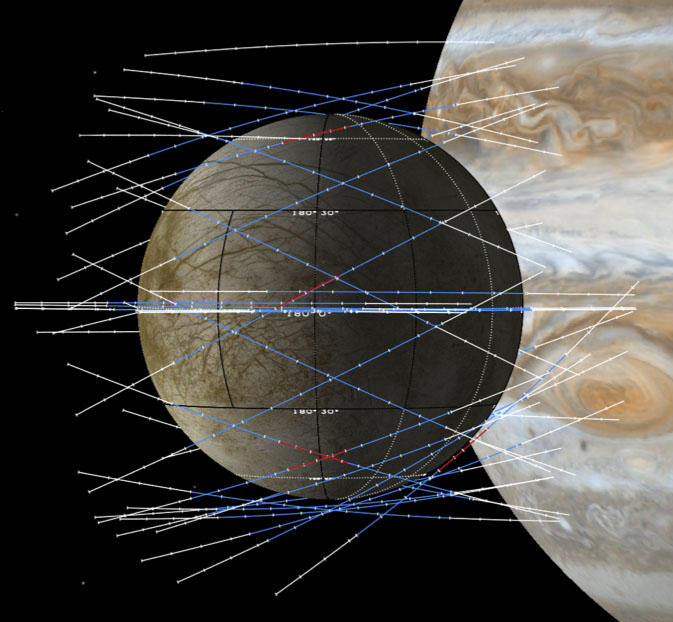
The Clipper will carry a robust set of instruments designed to clarify the depth of the ice sheet, map the organic chemicals on the surface, and image most of the moon’s surface, among other things. We need to know once and for all if Europa has an ocean, what the extent of the ocean is, and if there’s a viable way for the ocean and the surface to connect. The Clipper should give us the clarity we need.
There’s also a plan for a Europa lander, though it’s just a concept at this point. The proposed lander would drill down to the heart of the question. Somehow—we’re not sure yet—the lander would pierce the ice and get instruments or probes into the moon’s ocean. It would use a Radioisotope Thermoelectric Generator to generate the heat needed to bore through the ice. A less ambitious mission design might only drill a few inches into the ice. Biosignatures from the ocean might be present there, especially if this study is correct and ocean water can reach the surface.
In their summary, the authors explain how their results may apply to more than just Europa. Their viscous foundering mechanism might explain activity on other frozen worlds. They specifically mention Saturn’s moon Titan, the only body other than Earth with surface liquid. Titan might have an icy crust and an ocean rich in ammonia. While the surface liquid is hydrocarbons, the subsurface ocean is probably water.
Rosaly Lopes is the directorate scientist for the Planetary Science Directorate at NASA’s Jet Propulsion Laboratory. In a press release, she said that this model can help scientists understand the role impacts might have on other icy worlds.
“In the case of Titan, this is very important because Titan has a thick ice crust — thicker than Europa’s,” she said. “We’re really interested in the application of this study.”
More:
- Press Release: Comet Impacts Could Bring Ingredients for Life to Europa’s Ocean
- New Research Letter: Surface-To-Ocean Exchange by the Sinking of Impact-Generated Melt Chambers on Europa
- 2015 Research Article: Impact breaching of Europa’s ice: Constraints from numerical modelling
- Universe Today: Here are the High-Resolution Images of Europa Captured by Juno During its Recent Flyby

